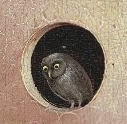








Falk, Kurt. The Unknown Hieronymous Bosch, Golden Stone 2008.
Kurt Falk was a believer in the turn of the century Austrian "clairvoyant" cultist Rudolf Steiner. Steiner claimed to have a spiritual perception way above all other people, so he could not be criticised. He presented his opinions as spiritual perceptions with which one could not quibble, after all we mere mortals could not see into the inner workings of the spiritual world as he could. Steiner's nonsense has survived him and there is still a flourishing group of people who totally and unquestioningly believe in his pronouncements. Falk, who died in 1986, worked in one of the centres that followed Steiner's anthroposophy. This entirely coloured his way of looking at Bosch's paintings.
Falk sees Bosch as an initiate who was using his paintings as a means of promoting an esoteric spiritual view of Mankind's place in the world. Strangely, the particular esoteric view Bosch adopts is not that found in his own century, but instead corresponds closely to that brand of esoteric Christianity devised by Steiner in the 20th century. Thus to follow Falk's view of Bosch we readers have to be prepared to accept that Bosch was familiar with Steiner's etheric bodies, astral bodies, kamaloca, the 'consciousness soul', cosmic evolutionary periods which Steiner named 'Saturn', 'Moon' and so on.
Here is part of his interpretation of the Garden of Earthly Delights.
"The space at the top of the painting remains open, open to infinity, open for never-ending cosmic creative acts. It is the sphere of Ichthys, the true sphere of Christ. New destinies of mankind and earth are formed here, new stages of existence of our planet are prepared. Here the earth past and cosmic future meet. And yet at the same level on the painting, where here the new illumined earth ascends to fresh spheres of development, to new earth beginnings as a light-permeated sphere, as a new earth embryo supported by its genius, the right-hand panel of the triptych depicts the end of the world, conflagration and destruction."Would Bosch have understood anything of this, even if translated into 15th century Dutch? Such ideas are of our time, not his. Another problem with the Falk interpretation is that Steiner's anthroposophy, being derived from Madame Blavatsky's eastern leaning Theosophical Society, incorporated the idea of reincarnation and karma. Falk continually refers to this in his interpretation of the painting. Reincarnation and karma, were just not a part of the late 15th early 16th century Northern European religion, especially not in Catholic 's-Hertogenbosch. Bosch could have had no exposure to such ideas.
Falk is particularly concerned with the Treeman image. Saying about the expression in the Cairo Last Judgement,
"This countenance, with its deeply serious gaze, reminds us of a Christian initiate who is neither paralyzed by Ahrimanic actions nor lulled to sleep by Lucifer hopes of self-redemption."More anthroposophical terms!
"…the face of the Treeman in the Cairo Last Judgment represents an enhancement of the visionary consciousness. His strengthened "I" has given him full insight and knowledge. As an initiate he is now unconstrained in these worlds and has a commanding view of the whole drama of mankind."How can Falk read so much into the rather poor copy of Bosch's original image, by one of the unknown apprentices in his workshop?
Falk particularly focuses on the Last Judgement painting in Cairo, which no scholar would assign to Bosch. This is likely to be a painting from Bosch's workshop, created by his apprentices and copying elements from Bosch's Garden of Earthly Delights. A number of such workshop pieces have been identified, copying imagery from Bosch's paintings, and this particular one is entirely in the same style. The quality of the actual painting is quite poor, as can easily be seen by comparing the images it copies from the Garden of Earthly Delights with the original. However, Falk convinces himself, and tries to convince the reader, that somehow it was an important part of Bosch's oeuvre, and that he had worked various coherent spiritual messages into this triptych.
Falk eagerly descends on Bosch's paintings, presenting the artist as an initiate familiar with Steiner's anthroposophy, who painted in order to present this particular strain of esoteric Christianity to the world. People such as Falk, who believe in such cultish ideas, seem to have the arrogance to pull the work of an artist such as Bosch into their mindset. It is all very well when anthroposophists stay in their own limited world, who cares if some people need to believe in some system of ideas, that is their existential problem, but it is annoying when they press their nonsense onto real people such as Hieronymus Bosch. Falk throws his barrage of esoteric theories at Bosch's paintings, presenting our painter as some kind of initiate, with some task to enlighten humanity. He draws on earlier Bosch commentators, Fraenger and Wertheim Aymes and wheels out a mass of esoteric ideas of which Bosch knew nothing. He never heard of them. They are inventions of 20th century esotericism and Steiner's imagination. Falk read this back into Bosch's work. Poor old Bosch is buried in esoteric gobbledegook. One feels sorry for Bosch that an intelligent person was so obsessed with such esoteric nonsense that he needed to vent this on one of the greatest of early Netherlandish painters.
Falk's book is entitled The Unknown Hieronymus Bosch. When one reads his book one will be totally certain that Bosch both as a person and artist was entirely unknown to Falk. He instead invents for us an initiate in a brand of esoteric Christian esotericism. The first two sentences of his book warn us not to proceed further.
"The present study of the painter Hieronymus Bosch represents a strange and intrepid adventure. It is a venture against reason, based purely on an act of contemplation, on an experience."Were that he had kept it as his own experience and not thought to impose this on the much abused painter.






